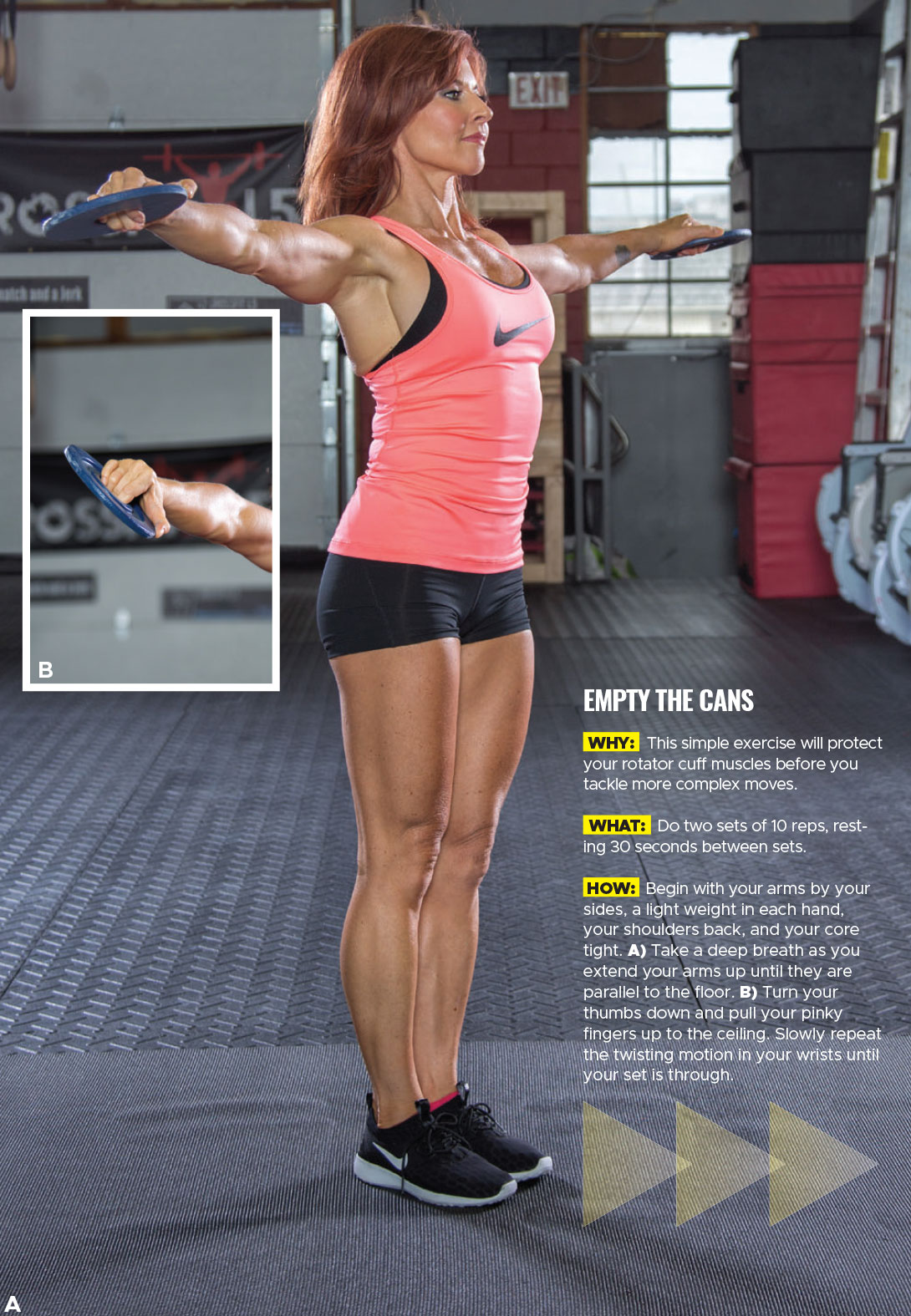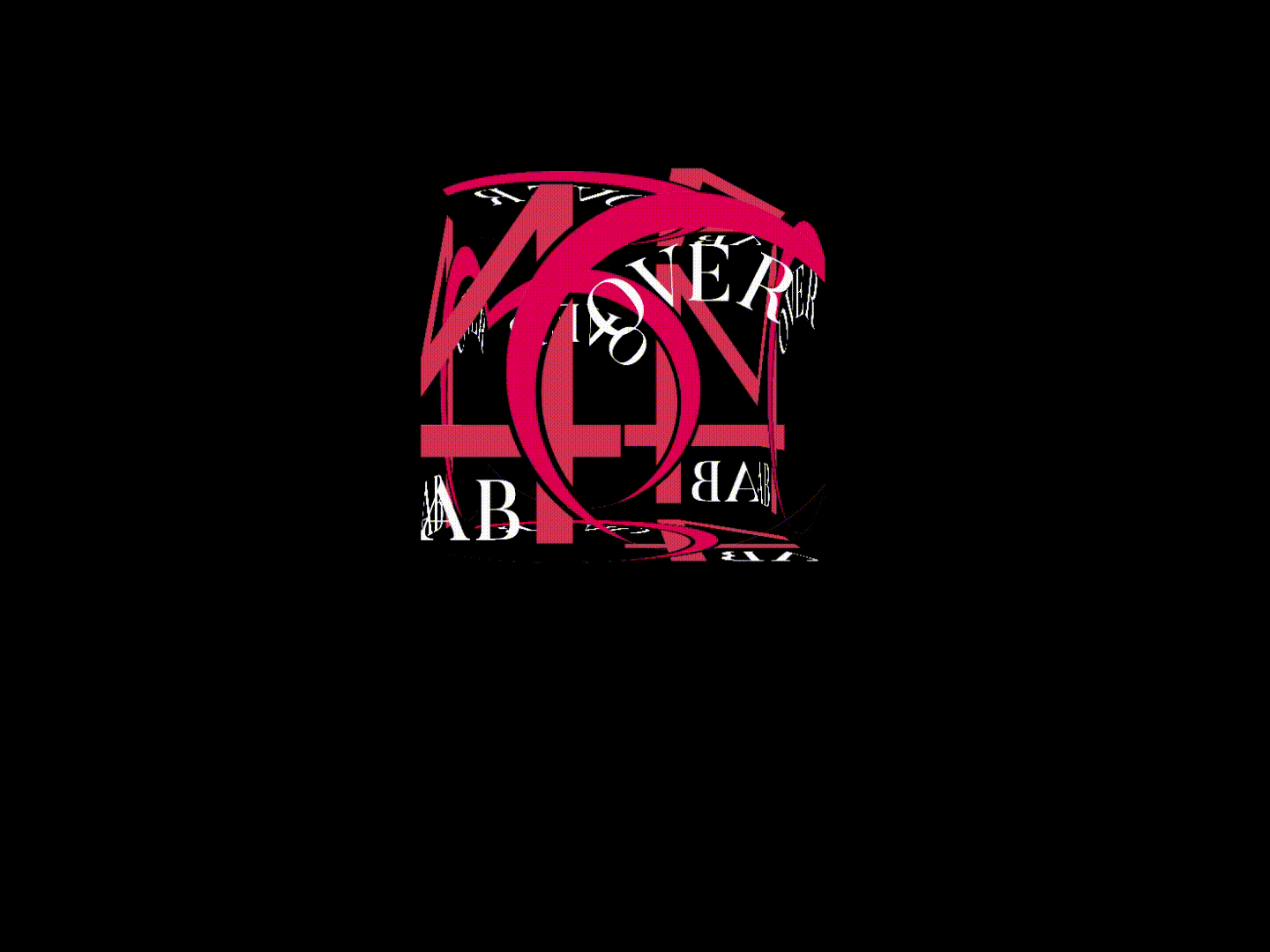Strength Training for an Awe-Inspiring Lower Body
Don’t let the thought of Olympic and powerlifting workouts intimidate you: our cover phenom Michelle MacDonald says everyone should be doing these awe-inspiring motions. She dishes on how she used these heavy moves to completely reshape her lower body. What she prescribed to her mom to get her into the best shape of her life – at 71 years of age.
Working out has always been a big part of my life, but in the past couple of years, I’ve turned my focus from training solely to looking good to training for strength. In 2010, I started seriously lifting weights to get in shape for physique competitions. After my last show in 2015, however, I decided I wanted to try my hand at powerlifting. Unfortunately, being a smaller and older athlete, lifting heavy weights didn’t come naturally to me. The first strength program I tried was something my husband gave me, and I remember removing the squats because I didn’t want my legs to get too big.
But by the end of that program, I was in love with the technical aspects of lifting heavy weights and how structured the programming was. I decided to train for my first powerlifting meet, learned how to squat properly, and haven’t looked back since. I’ve definitely gained muscle training this way, it’s fired up my metabolism like nothing else, and the workouts always challenge me. Try it, and I think you’ll agree.
HOW TO DO IT
Start by foam rolling the major muscle groups in your lower body (hamstrings, quads, glutes) for a total of two minutes. Do the mobility exercises as described, followed by the strength exercises, and finally end with a five-minute cooldown of glute and leg stretches and additional foam rolling.

McGILL SIT-UP
WHY: McGill sit-ups are designed to activate your core muscles properly in preparation for heavy bracing.
WHAT: Do two sets of 10 reps on each side, resting 30 seconds between sets.
HOW: Lie on your back with one leg bent and the other leg extended on the floor with your foot flexed. Keeping the small of your back pressed against the floor, exhale and slowly crunch up, extending both arms toward the ceiling. Reverse slowly to complete one rep.
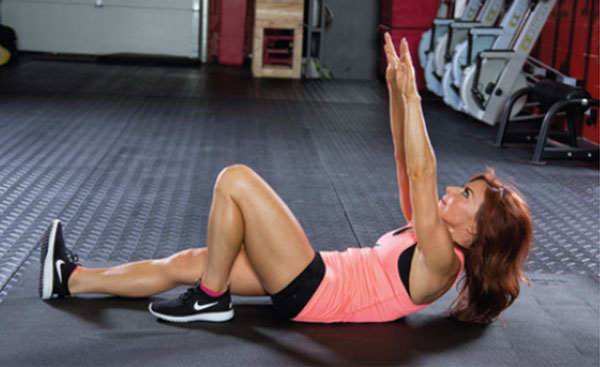
GLUTEAL BRIDGE MARCH
WHY: Gluteal bridge marching activates the gluteal, hamstrings, and core muscles in preparation for squatting.
WHAT: Do two sets of 20 reps with 30 seconds of rest between sets.
HOW: Lie on your back with your knees bent, feet flat on the floor. Keeping your arms on the ground by your sides for balance and your core muscles tight, use your gluteal muscles to push your hips upward to lift your butt from the floor. Alternate lifting each leg toward the ceiling without straightening the knee or twisting the hips. Lower slowly back to the start to complete one rep.
TIP
Time your breaths: exhale on the up, inhale as you lower.
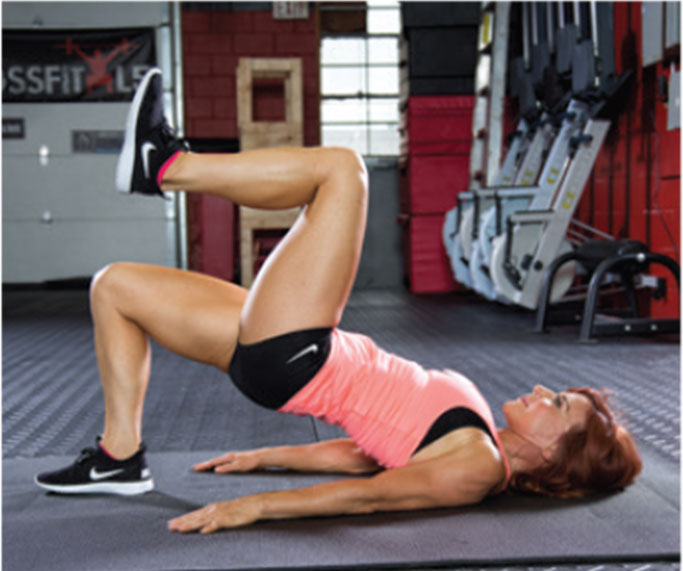
EMPTY THE CANS
WHY: This simple exercise will protect your rotator cuff muscles before you tackle more complex moves.
WHAT: Do two sets of 10 reps, resting 30 seconds between sets.
HOW: Begin with your arms by your sides, a lightweight in each hand, your shoulders back, and your core tight. A) Take a deep breath as you extend your arms up until they are parallel to the floor. B) Turn your thumbs down and pull your pinky fingers up to the ceiling. Slowly repeat the twisting motion in your wrists until your set is through.
BANDED MONSTER WALK
WHY: Another great way to activate the hip muscles and knees.
WHAT: Walk 20 yards, rest for 30 seconds, then repeat once.
HOW: Loop a medium resistance band around your ankles. Lower into a semi-crouched position with knees bent and feet a bit wider than the hips. Step one foot forward, keeping the knee tracking over the toe, and then step the opposite foot forward. Maintain this crouched position, ensuring the band stays taut, as you walk across your workout area.
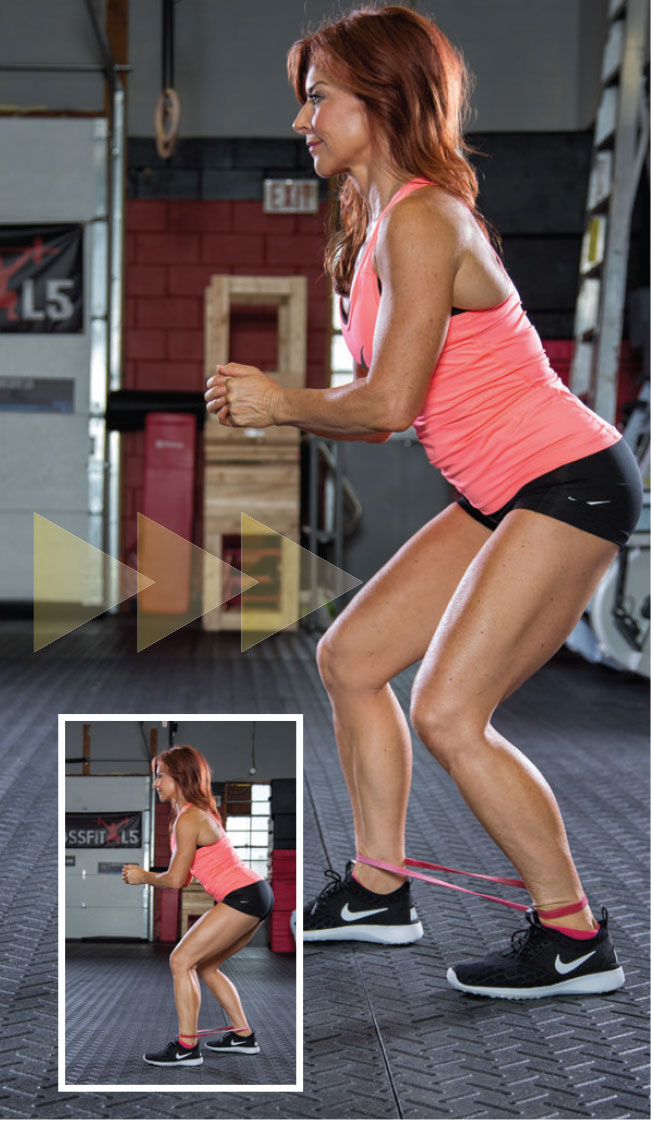
OFFSET SQUAT
WHY: This is one of the best exercises to open up your hips and teach you how to squat properly.
WHAT: Do two sets of 10 reps with 20 seconds of rest between sets.
HOW: [A] Start by holding a lightweight against your chest and space your feet a little wider than hip-width apart. [B] Take a deep breath, brace your core, and press the weight in front of you as you bend at the hips and knees to squat down. As you stand back up to finish one rep, bring the plate back toward your chest
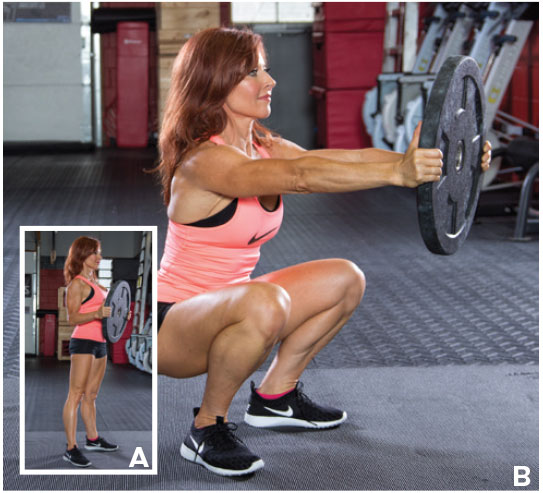
30-INCH BOX JUMP
WHY: These jumps activate the fast-twitch muscles of your legs and hips, and will help you develop more explosive power.
WHAT: Perform three sets of three jumps, resting one minute between sets.
HOW: Stand about two feet from a 30-inch box. Breathe in deeply, bend your hips and knees, and swing your arms behind you. Explosively jump up onto the box, shooting your arms forward as you leap. Land with soft feet, about hip-distance apart.
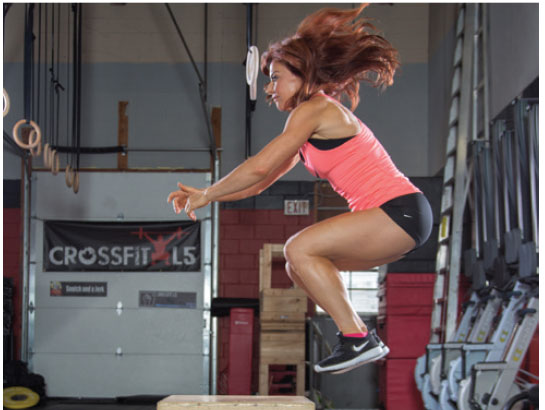

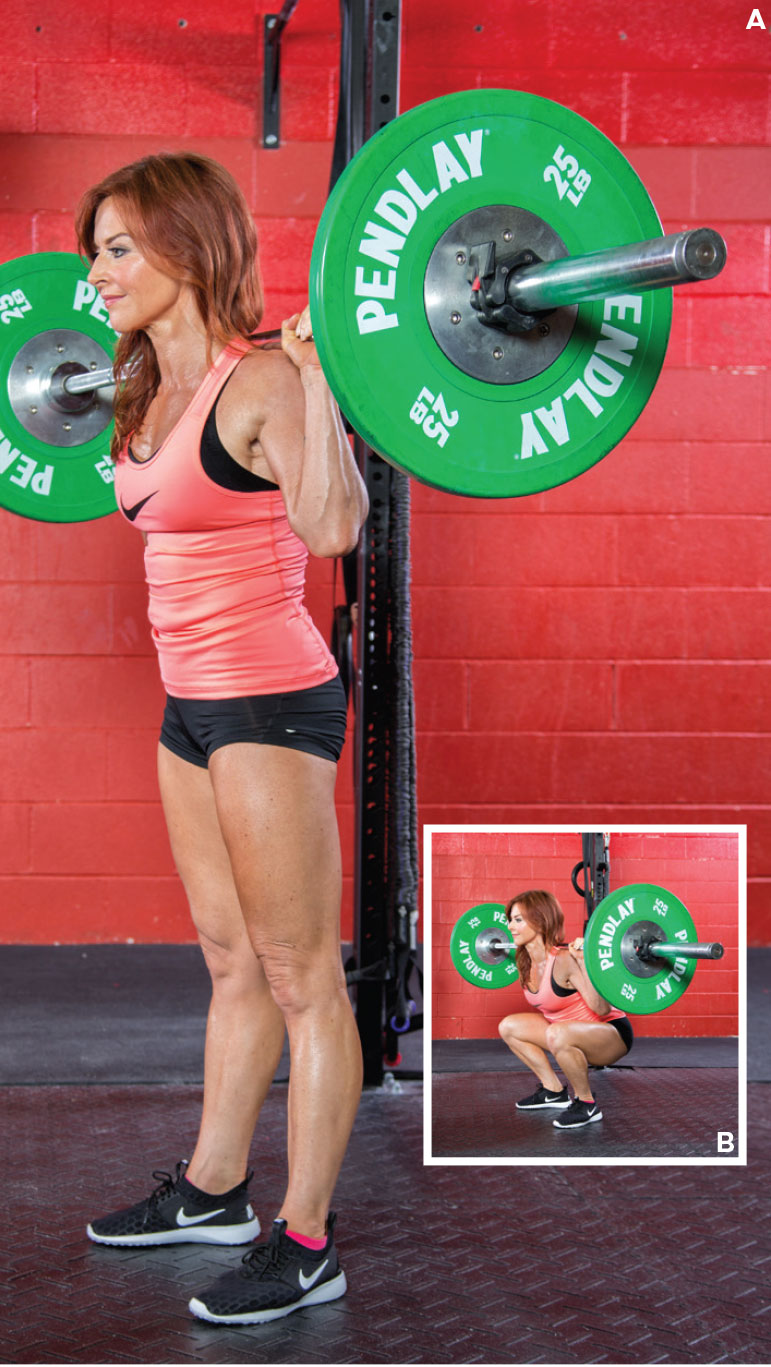
OLYMPIC SQUAT
WHY: These upright squats place a lot of emphasis on quad development.
WHAT: Do five sets of four reps each, using 90% of your four-rep max. (Your four-rep max is a weight that will fatigue you within four reps – for this exercise, chose a weight with which you could probably do two more reps after you reach your fourth.)
HOW: Stand in front of a bar resting about shoulder height on a rack. Grasp the bar firmly with both hands and pull the bar onto your upper traps. Squeeze your elbows toward the sides of your body, flaring them slightly forward to engage the lats. Take a deep breath, brace your core, and unrack the bar. [A] Move forward three steps away from the rack, positioning your feet a little wider than shoulder-width apart, toes slightly pointed out. Exhale, then take a deep breath into your belly, expanding your waist. [B] Hold your breath as you squat all the way down, keeping a straight back and maintaining a lifted chest. To come up, flare the elbows forward, push the knees out over the toes, and use the quad muscles to extend back to the start.
FRONT SQUAT
WHY: Front squats are great for developing the quads and strengthening the core muscles, which help you maintain an upright position throughout the motion.
WHAT: Do four sets of five reps at about 70% of your five-rep max. (This means a weight at which you could probably do three more reps once you reach your fifth.)
HOW: Stand with a racked barbell in front of you at shoulder height. [A] Grasp the bar with hands spaced a little wider than the shoulders. Drive your elbows up and forward so that the palms of your hands now face up, and push the bar into your collarbone so that itrests across the front of your shoulders. Take a deep breath and unrack the bar, walking about three steps back and placing your feet about hip-distance apart with toes pointed slightly out. [B] Exhale slightly, and then take a deep breath into the belly, expanding your waist, and squat all the way down. Keep your elbows lifted and your forearms parallel to the ceiling. To come up, push your knees out and use the quads to stand back up. Exhale at the top.
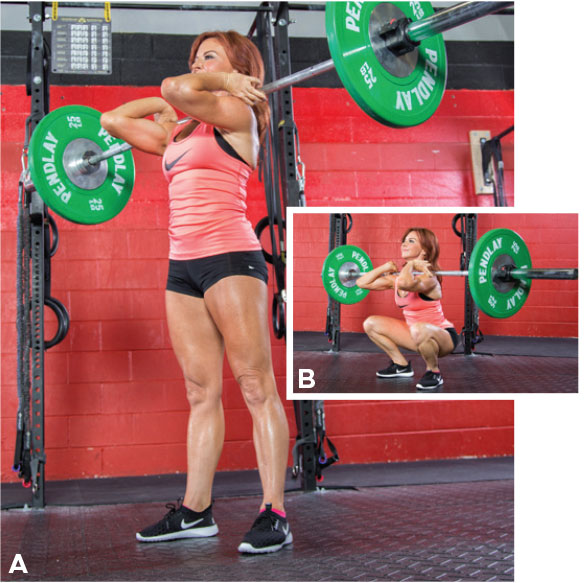
BOX DEADLIFT
WHY: A variation of the Romanian deadlift, will help you gain a greater range of motion to further develop the hamstrings. The key difference is that the shins must stay vertical by keeping the calves in contact with a box or roller set up behind the lifter.
WHAT: Do three sets of five reps at 70% of your five-rep max. (At the end of your set, you should feel as though you could do three to four more reps.)
HOW:[A] Stand with a roller or box behind you (see inset) and a heavy barbell on the floor in front of you. Take a deep breath, brace your core, and bend forward from the hips to grasp the bar with both hands, one palm facing you and one facing away. [B] Bend slightly at the knees, push your feet into the floor and extend from the hips to pull the bar up, keeping it in contact with your thighs at all times. Exhale at the top. Take a big breath, contract your abs, and lean forward to lower the bar down your thighs until the bar is just past your knees. Remember to continuously push the calves back against the box or roller from start to finish to maintain their beneficial upright position.

WALKING LUNGE
WHY: Walking lunges are unilateral movements. They improve hip mobility, strengthen the muscles that stabilize the hips, and are great for developing the quads and gluteal muscles.
WHAT: Do two sets of 20 lunges each. Select a weight that is challenging but allows you to maintain good form, and use wrist straps to help support the resistance in your hands if needed.
HOW: Stand with your feet together, holding a weight in each hand. Step one foot forward and bend your knees so the back knee brushes the ground and the front knee is at a 90-degree angle and tracking over the toes. Push your front foot into the floor to rise and bring the back foot forward to meet the front foot. This is one rep. Alternate feet for your entire set
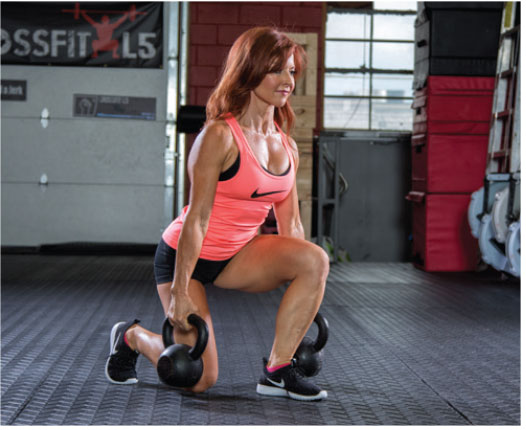
GOOD MORNING
WHY: This is a sorely neglected exercise. It teaches how to properly hinge the hips, develops the glutes, and really builds your back.
WHAT: Do three set of eight reps. Choose a challenging weight that will still allow you to complete a full range of motion.
HOW:[A] Unrack the bar in the same manner you did for the Olympic Squat, but this time place the bar a little bit lower on your back so that it sits on the rear deltoids instead of the upper traps. Start with your feet a bit wider than the hips. [B] Take a deep breath and brace your core as you push your hips back and lean forward, bending slightly at the knees. Your back must stay absolutely straight throughout the movement. If you can get your torso parallel to the floor by pushing the hips back as far as possible. Keep your weight on the heels of your feet. To rise, flare your elbows in front and drive your hips forward as you push your back against the bar. Repeat for your set.
PHOTOS BY @chrisvlinton


